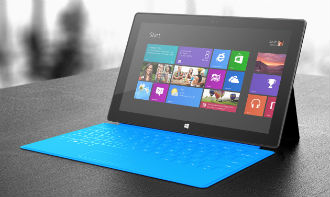 Microsoft’s Surface RT tablet rollout came and went without much fanfare. Although Redmond’s first crack at the tablet market received relatively positive reviews, consumers seem unfazed and many of them are choosing to trade in their new tablets.
Microsoft’s Surface RT tablet rollout came and went without much fanfare. Although Redmond’s first crack at the tablet market received relatively positive reviews, consumers seem unfazed and many of them are choosing to trade in their new tablets.
IHS iSuppli estimates that channel shipments totaled about 1.25 million units, but far fewer have been sold. In fact, as little as 680,000 to 750,000 units appear to have actually been sold. As a result, Microsoft has scaled back production, as it is already suffering from carryover inventory.
Rhoda Alexander, an analyst at iSuppli, told CNET that sales out of the channel were significantly lower than overall shipments, probably in the 55 to 60 percent range. In addition, many consumers who picked one chose to return it and Alexander said the return rate is very high.
“If you put the high return rate together with low sell-through [sales out] rate, that’s indicative of a problem,” she said. “It seems to be linked in a lot of cases to a steep learning curve of the OS — which is not necessarily intuitive.”
There are other problems, too. Few device makers have chosen to jump on the Windows RT bandwagon, focusing their efforts on Android instead. It is also more than likely that many hardware makers will embrace Windows 8 over Windows RT, as the general feel is that Windows 8 tablets with support for x86 legacy applications are a safe bet, while RT is about as safe as an investment in Greek bonds. Moreover, Microsoft plans to launch the Surface Pro later this month and many consumers who had their doubts about the RS version could go for the pricier Pro version, with Windows 8 and a proper x86 processor.
The other problem facing the Surface RT is its outdated hardware. It features a 1366×768 display, Tegra 3 processor, 2GB of memory and 32GB or 64GB of storage. The competition offers more for less, plain and simple. The iPad 4 packs a Retina screen and it’s powered by the A6X SoC, one of the fastest mobile chips around. The Nexus 10 has a 2560×1600 display and a dual-core Exynos chips based on ARM’s latest A15 core. What’s more, Surface RT is a rather bloated OS and it takes up quite a bit of room, so the 32GB Surface RT actually offers only about 16GB of user-accessible storage.
Microsoft is still charging $499 for the entry 32GB Surface with no keyboard cover. Consumers who opt for the keyboard cover bundle are expected to pay $599. That is iPad money, and it’s quite a bit more than what Google asks for the Nexus 10. Although it was introduced in late October, the Surface RT is already starting to look like an outdated and overpriced piece of kit. A price cut would make sense and it could rekindle interest in the fledgling tablet, but it can’t address the lack of headline grabbing hardware or the limited ecosystem.
If the Surface Pro tanks, and if hardware makers don’t embrace Windows 8 tablets, Microsoft will be forced to rethink its tablet strategy, but it doesn’t have much room for maneuver. It is already committed to Windows 8 and Windows RT, but the latter is already starting to look like a Zune-esque flop.





